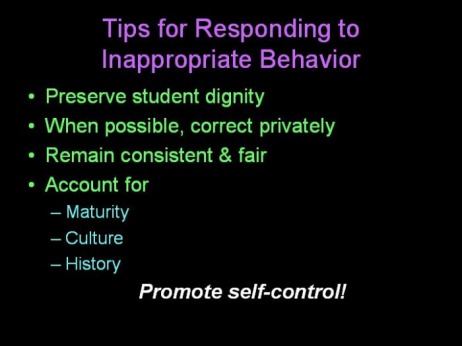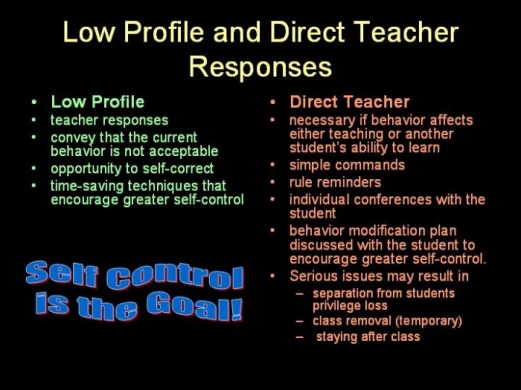Responding to Inappropriate Behavior

The final step in creating a healthy and happy learning environment is knowing how to respond to inappropriate behavior as it arises.
Description:
Though previously mentioned, it is worth noting again that the purpose of discipline is to encourage students toward greater self-control. Therefore, the response to inappropriate behavior needs to model this to them. In disciplining, there are four main factors for the teacher to consider. First, “preserve student dignity” (Savage, 1999). The teacher is attempting to turn the misbehavior into a valuable lesson, not degrade the student by embarrassment. Maintaining dignity builds positive trusting relationships instead of tearing them down. Next, whenever possible, correction should be done in private. If this cannot occur, the teacher should make it as low-profile as possible, not drawing attention to the situation. Again, humiliation will not benefit the student in any way and can create issues between the student and teacher later on. Third, the teacher should be consistent and fair. The same rules apply to all students, and fairness is essential. Finally, identify the causes of misbehavior, so they can be addressed appropriately. For example, is it a cry for help? This may be the student’s only known way to do so. Look deeply into a matter for any underlying causes (Savage, 1999).
When choosing a response, bear in mind the maturity level, culture, and history of the student. All of these factors can bear great weight on the response to an issue. Also, the teacher should remember that the goal is promoting self-control and responses can be used to aid this. Maintain positive relations with parents so that if an issue arises, you can work together to solve the problem. Time, resources and administrative support are all factors as well. Finally, the severity of the behavior warrants its response. For minor issues, a low profile response is necessary. Other issues may result in direct teacher intervention, or serious consequences. (Savage, 1999).
Significance:
No matter how effective a teacher is, misbehavior is bound to occur at some point. Knowing the steps to take care of this while maintaining the goal of self-control is essential. It turns misbehavior into an opportunity for growth.
Demonstration:
Sally continually interrupts the teacher and other students by speaking without being called on. The teacher has clearly established that students are to raise their hands before speaking. When speaking to Sally in private, the teacher becomes aware that she is looking for attention. As a result, the teacher finds an alternative way for Sally to express this in a positive manner. The teacher explains to Sally why it is important not to talk, she teaches her some physical responses, such as crossing arms or legs to do when she feels the urge to speak out of turn. The teacher also allows Sally to be a group leader in an upcoming project to address her need for attention. Finally, she offers her many opportunities to speak up at appropriate times in class. (McCarney & Wunderlich, 2006).
Integral Components:
Developing a low profile approach involves positive responses. These include praising and support of appropriate behavior. Positive reinforcement is often an effective tool for maintaining discipline. Low profile responses also include teacher responses. Similar to meaning business, these subtly convey that the current behavior is not acceptable. They offer the student the opportunity to self-correct, or fix behavior without any direct teacher involvement. These are time-saving techniques that encourage greater self-control. Direct teacher intervention is necessary if behavior affects either teaching or another student’s ability to learn. Responses to these behaviors include simple commands, rule reminders, individual conferences with the student, and/or a behavior modification plan discussed with the student to encourage greater self-control. Serious issues may result in separation from students, privilege loss, class removal (temporary), or staying after class. (Savage, 1999).
Individualization:
I plan to use these techniques in my class whenever misbehavior occurs. By using the appropriate responses, students can gain alternatives to misbehavior and achieve greater self control.
Spiritual Application:
2 Timothy 3:15-17 states, “All Scripture is God-breathed and is useful for teaching, rebuking, correcting and training in righteousness, so that the man of God may be thoroughly equipped for every good work” (NIV). In the Christian walk, we are to use the word of God as a standard by which to live. As seen in this verse, this includes correction for improvement. As teachers, we model this, using the Bible as our guide. It is our responsibility to encourage children toward greater growth based on biblical principles (stated or unstated depending on the setting).


